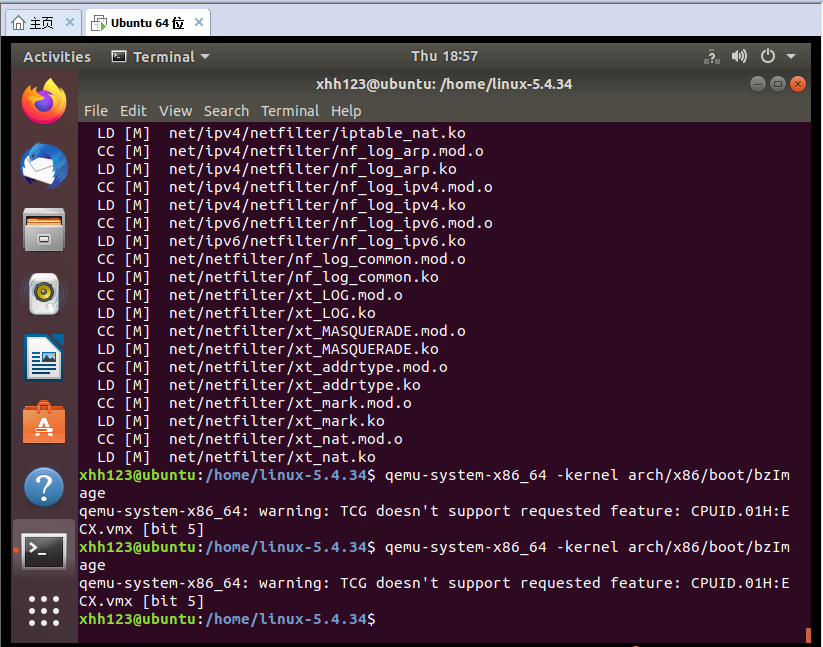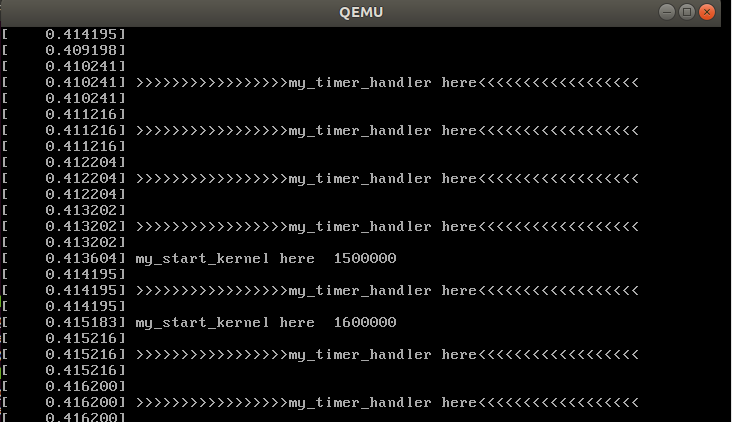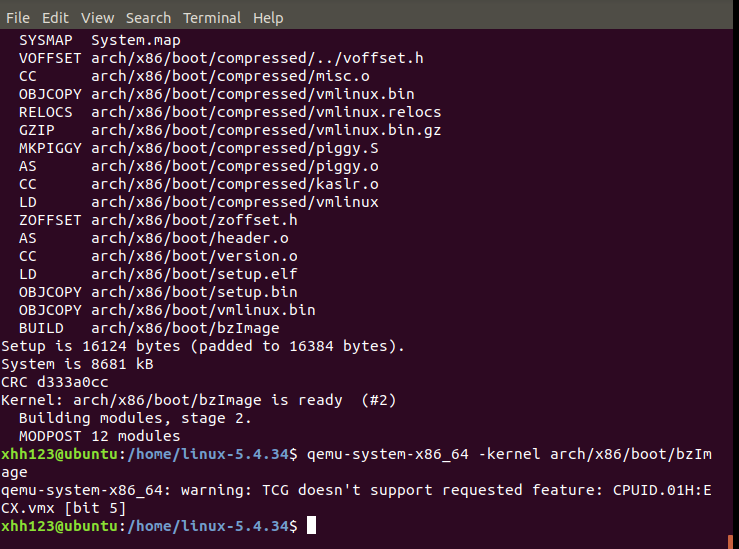实验要求
1,按照https://github.com/mengning/mykernel 的说明配置mykernel 2.0,熟悉Linux内核的编译。
2,基于mykernel 2.0编写一个操作系统内核,参照https://github.com/mengning/mykernel 提供的范例代码。
3,简要分析操作系统内核核心功能及运行工作机制。
实验内容
安装linux系统,下载mykernel2.0补丁,下载在linux虚拟机上下载开发工具qemu,以及下载linux源码,具体代码如下:
wget https://raw.github.com/mengning/mykernel/master/mykernel-2.0_for_linux-5.4.34.patch
sudo apt install axel
axel -n 20 https://mirrors.edge.kernel.org/pub/linux/kernel/v5.x/linux-5.4.34.tar.xz
xz -d linux-5.4.34.tar.xz
tar -xvf linux-5.4.34.tar
cd linux-5.4.34
patch -p1 < ../mykernel-2.0_for_linux-5.4.34.patch
sudo apt install build-essential libncurses-dev bison flex libssl-dev libelf-dev
make defconfig # Default configuration is based on 'x86_64_defconfig'
make -j$(nproc)
sudo apt install qemu # install QEMU
qemu-system-x86_64 -kernel arch/x86/boot/bzImage
通过运行产生如下结果:


通过mymain.c和 myinterrupt.c 程序可以看出 mymain.c 通过每次计数达到100000输出一次my_start_kernel here从而不停的执行。
同时还具有一个中断处理程序的上下文环境,周期性的产生时钟中断信号,触发myinterrupt.c程序执行输出 my_timer_handler here。
这样就通过Linux内核代码模拟了一个具有时钟中断和C代码执行环境的硬件平台。
基于mykernel 2.0编写一个操作系统内核
基于上述mykernel来编写一个操作系统内核,我们首先需要添加一个mypcb.h头文件,其代码如下:#define MAX_TASK_NUM 4
#define KERNEL_STACK_SIZE 1024*2
/* CPU-specific state of this task */
struct Thread {
unsigned long ip;
unsigned long sp;
};
typedef struct PCB{
int pid;
volatile long state; /* -1 unrunnable, 0 runnable, >0 stopped */
unsigned long stack[KERNEL_STACK_SIZE];
/* CPU-specific state of this task */
struct Thread thread;
unsigned long task_entry;
struct PCB *next;
}tPCB;
void my_schedule(void);同时要修改mymain.c中的my_start_kernel函数,该函数是内核初始化函数,用来在内核启动时初始化一系列模块,具体添加代码如下:
#include "mypcb.h"
tPCB task[MAX_TASK_NUM];
tPCB * my_current_task = NULL;
volatile int my_need_sched = 0;
void my_process(void);
void __init my_start_kernel(void)
{
int pid = 0;
int i;
/* Initialize process 0*/
task[pid].pid = pid;
task[pid].state = 0;/* -1 unrunnable, 0 runnable, >0 stopped */
task[pid].task_entry = task[pid].thread.ip = (unsigned long)my_process;
task[pid].thread.sp = (unsigned long)&task[pid].stack[KERNEL_STACK_SIZE-1];
task[pid].next = &task[pid];
/*fork more process */
for(i=1;i<MAX_TASK_NUM;i++)
{
memcpy(&task[i],&task[0],sizeof(tPCB));
task[i].pid = i;
task[i].thread.sp = (unsigned long)(&task[i].stack[KERNEL_STACK_SIZE-1]);
task[i].next = task[i-1].next;
task[i-1].next = &task[i];
}
/* start process 0 by task[0] */
pid = 0;
my_current_task = &task[pid];
asm volatile(
"movq %1,%%rsp
" /* set task[pid].thread.sp to rsp */
"pushq %1
" /* push rbp */
"pushq %0
" /* push task[pid].thread.ip */
"ret
" /* pop task[pid].thread.ip to rip */
:
: "c" (task[pid].thread.ip),"d" (task[pid].thread.sp) /* input c or d mean %ecx/%edx*/
);
}
int i = 0;
void my_process(void)
{
while(1)
{
i++;
if(i%10000000 == 0)
{
printk(KERN_NOTICE "this is process %d -
",my_current_task->pid);
if(my_need_sched == 1)
{
my_need_sched = 0;
my_schedule();
}
printk(KERN_NOTICE "this is process %d +
",my_current_task->pid);
}
}
}
my_start_kernel函数首先对0号进程进行初始化,将进程的程序入口地址设置为my_process 函数,
接下来继续初始化剩余进程并将进程通过链表形式来进行链接,其中各进程之间的 pid 和栈顶指针以及指向下一进程的指针都不相同。
最后通过一些列汇编代码来启动0号进程。接下来的my_process函数是通过进程运行完一个时间片后主动让出CPU的方式,
通过判断my_need_sched的值来决定是否调用my_schedule()函数来进行进程之间的切换。
下面修改myinterrupt.c的代码:
#include "mypcb.h"
extern tPCB task[MAX_TASK_NUM];
extern tPCB * my_current_task;
extern volatile int my_need_sched;
volatile int time_count = 0;
/*
* Called by timer interrupt.
* it runs in the name of current running process,
* so it use kernel stack of current running process
*/
void my_timer_handler(void)
{
if(time_count%1000 == 0 && my_need_sched != 1)
{
printk(KERN_NOTICE ">>>my_timer_handler here<<<
");
my_need_sched = 1;
}
time_count ++ ;
return;
}
void my_schedule(void)
{
tPCB * next;
tPCB * prev;
if(my_current_task == NULL
|| my_current_task->next == NULL)
{
return;
}
printk(KERN_NOTICE ">>>my_schedule<<<
");
/* schedule */
next = my_current_task->next;
prev = my_current_task;
if(next->state == 0)/* -1 unrunnable, 0 runnable, >0 stopped */
{
my_current_task = next;
printk(KERN_NOTICE ">>>switch %d to %d<<<
",prev->pid,next->pid);
/* switch to next process */
asm volatile(
"pushq %%rbp
" /* save rbp of prev */
"movq %%rsp,%0
" /* save rsp of prev */
"movq %2,%%rsp
" /* restore rsp of next */
"movq $1f,%1
" /* save rip of prev */
"pushq %3
"
"ret
" /* restore rip of next */
"1: " /* next process start here */
"popq %%rbp
"
: "=m" (prev->thread.sp),"=m" (prev->thread.ip)
: "m" (next->thread.sp),"m" (next->thread.ip)
);
}
return;
}上述代码都修改完成后,重新编译内核,启动qemu,结果如下:


简要分析进程切换核心汇编代码:
asm volatile(
"pushq %%rbp
" /* 1 save rbp of prev */
"movq %%rsp,%0
" /* 2 save rsp of prev */
"movq %2,%%rsp
" /* 3 restore rsp of next */
"movq $1f,%1
" /* 4 save rip of prev */
"pushq %3
" /* 5 save rip of next */
"ret
" /* 6 restore rip of next */
"1: " /* 7 next process start here */
"popq %%rbp
" /* 8 restore rbp of next */
: "=m" (prev->thread.sp),"=m" (prev->thread.ip)
: "m" (next->thread.sp),"m" (next->thread.ip)
);
}
-
pushq %%rbp保存prev进程RBP寄存器的值到堆栈; -
movq %%rsp,%0保存prev进程RSP寄存器的值到prev->thread.sp,这时RSP寄存器指向进程的栈顶地址,实际上就是将prev进程的栈顶地址保存。 -
movq %2,%%rsp将next进程的栈顶地址next->thread.sp放⼊RSP寄存器,完成了进程的堆栈切换。 -
movq $1f,%1保存prev进程当前RIP寄存器值到prev->thread.ip,这⾥$1f是指标号1的地址。 -
pushq %3把即将执⾏的next进程的指令地址next->thread.ip⼊栈。 -
ret就是将压⼊栈中的next->thread.ip放⼊RIP寄存器,为什么不直接放⼊RIP寄存器呢?因为程序不能直接使⽤RIP寄存器,只能通过call、ret等指令间接改变RIP寄存器。